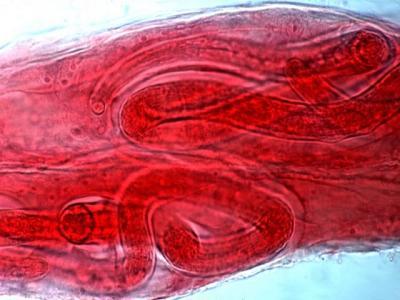The new research also has implications far beyond a single parasitic disease, the researchers say. T. spiralis is just one of many thousands of parasitic roundworms called nematodes that, according to the World Health Organization, infect 2 billion people worldwide, severely sickening 300 million. Other species of parasitic nematodes cause diseases in pets and livestock and billions of dollars of crop losses annually.
Among nematodes, T. spiralis diverged early, some 600-700 million years before the crown species, C. elegans, a model organism used in research laboratories. To date, the genomes of 10 nematodes, including five parasitic worms, have been decoded. The latest addition of the T. spiralis genome now allows scientists to compare species that span the phylum.
"T. spiralis occupies a strategic position in the evolutionary tree of nematodes, which helps fill in important knowledge gaps," explains senior author Richard K. Wilson, PhD, director of Washington University's Genome Center and professor of genetics. "By comparing nematode genomes, we have identified key molecular features that distinguish parasitic nematodes, raising the prospect that a single targeted drug may be effective against multiple species."
Over all, the genome of T. spiralis is smaller than that of C. elegans. It has 15,808 genes, compared to C. elegans' 20,000.
Moreover, about 45 percent of T. spiralis genes appear to be novel. These genes have not been found in other organisms and are not listed in public gene databases. The researchers say the worm's early evolutionary split or its distinctive lifestyle – it can't survive outside the body – may account for this extensive collection of enigmatic genes.
The researchers also found 274 families of proteins that are conserved among all nematodes and that do not exist in other organisms, including humans. Furthermore, they identified 64 protein families that are exclusive to parasitic nematodes.
"This provides opportunities for scientists to dig deeper into the distinctive features of parasitic nematodes that can be targeted with new drugs," Mitreva says. "If those drugs target molecular features unique to parasitic worms, it is more likely the side effects of those drugs will be minimal in humans."

Scientists have decoded the DNA of the parasitic worm that causes trichinosis, a disease linked to eating raw or undercooked pork or carnivorous wild game animals, such as bear and walrus.
(Photo Credit: Washington University)

Trichinosis is caused by eating raw or undercooked pork or carnivorous wild game animals, such as bear and walrus, infected with the parasitic worm, Trichinella spiralis. While the disease is rarely deadly, some patients live for months or years with chronic muscle pain and fatigue until the worms eventually die.
(Photo Credit: Photo by Jonathan Eisenback, Mactode Publications)